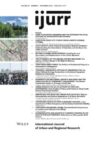In Australia, the coronavirus pandemic has given us the chance to make innovative housing transitions. Instead of rushing back to ‘housing crisis as usual’, we argue for a focus on healthy, productive and sustainable housing – the foundations of a just city.
The COVID-19 pandemic has shown that housing and home are not only essential components of urban infrastructure for pandemic crisis response, but also form a critical part of a healthy and sustainable recovery. As global leaders, urban planners and housing policy-makers and practitioners consider what comes after vaccines or virus elimination, we argue in favour of looking at existing housing stock and built environment as the first step in a rebuild strategy. Focusing on the example of Australia, the COVID-19 pandemic and its effects have shone a light on a variety of compounded existing housing problems, and other scholars and journalists have already illuminated these well. The pandemic has also created new issues, as more homes have taken on functions that were previously provided by public infrastructure – workplaces, schools, kindergartens, gyms. The very notion of what a house should provide its inhabitants has irreversibly changed.
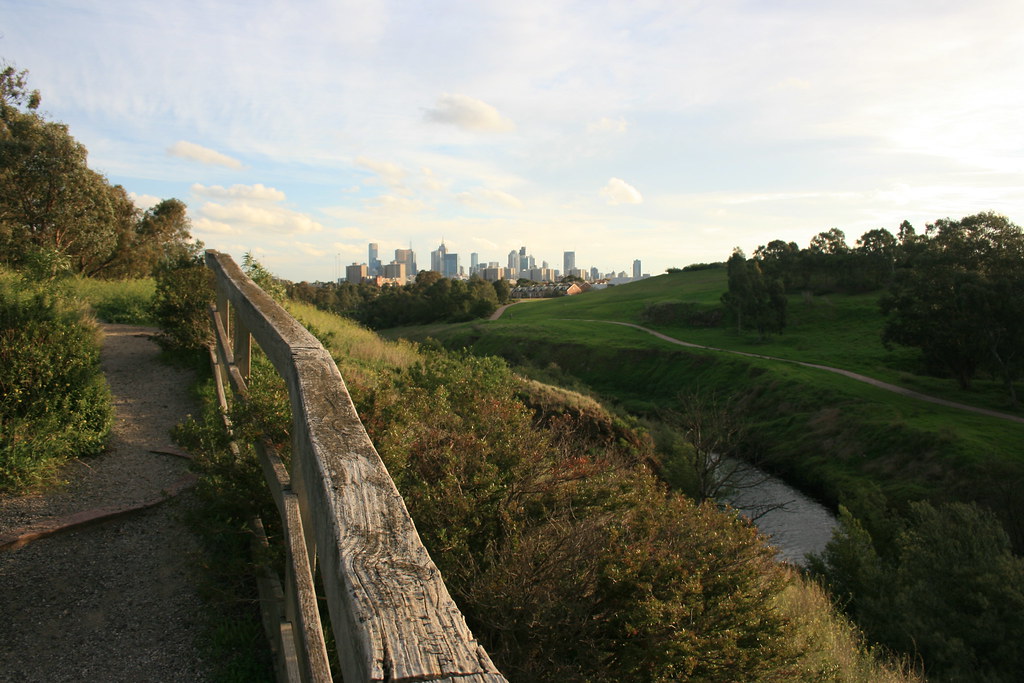
Melbourne city view from Capital City Trail: Space Cadet Marko (CC BY-NC-SA 2.0)
With change comes the potential for innovation – and we have seen that innovation is possible, from housing rough sleepers in hotels, to various relief measures for renters and landlords. But while these are great short-term measures, what happens in the long run? Although snapping back to “business as usual” is tempting, mounting evidence indicates that such a pathway will not achieve healthy, sustainable urban outcomes, for three reasons. First, “business as usual” in Australia equals a housing landscape riddled with inequalities – often referred to as a “housing crisis” in pre-pandemic terms, due to the high costs of both home ownership (the dominant tenure) and private rental (Australia’s growing tenure form). Second, the lockdowns of 2020 and the time it will take to reach “COVID normal” can be used to reflect on the types of housing and neighbourhood urban contexts that are resilient to future shocks, and to plan for how the innovations of 2020 can be used to achieve these. Third, an immediately resilient housing system is required as part of a first response to the substantial economic impacts of the pandemic. While predicting when Australia will regain a semblance of economic stability is difficult, there is a clear need for a housing system that is capable of stabilising the potential economic aftershocks of Australia’s coronavirus peak, including the potential introduction of mechanisms to slow the early-2021 post-pandemic purchasing rush on Australian residential properties. Attempting to rush back to “normal” is futile, and policies based on this preconception will only entrench current problems.
Although this essay offers a reflection on the broader Australian situation, our observations are necessarily shaped by our location in the state of Victoria, where the capital city of Melbourne recently emerged from three-and-a-half months of lockdown after a second wave of coronavirus infections. Even as this article was drafted, our situation changed rapidly from week to week. Now, at the start of 2021, we write from the position of a country cautiously planning for “post-COVID” life. Strict border controls between the states and territories are finally disappearing, early vaccination roll-out is underway but a national travel ban that prohibits leaving and entering the country (with strict exceptions) remains in place.
Public discourse about post-COVID cities often concentrates on ideas central to urban planning (such as repurposing our streetscapes and parking lots for pedestrian, cycling and social activities), but housing policies have an important role to play. Transitions to better housing futures (especially in the post-pandemic context) will need to capitalise on the innovations that have been created by COVID disruptions and be interdisciplinary and cross-sectoral. It is a window of opportunity for more just cities, and housing is central in this transition. While the recent Federal Budget in Australia has focused on only some aspects of building and construction (such as government assistance for first home buyers and loans to build affordable housing), it is important that housing as urban infrastructure is part of the agenda and that policy makers sustain a system’s view – or a sight of the bigger picture.
Our key proposition for post-pandemic housing futures that can build and support transitions towards just cities in Australia is to renew our focus on existing housing as an urban infrastructure that supports (mental and physical) health and wellbeing, productivity and sustainability. For such a renewed focus to guide housing policy and governance, innovative and cross-sectoral institutional actions that accelerate partnering between government, not-for-profits, businesses and researchers – and that achieve equitable outcomes for all residents – are essential. The COVID period shows that equitable outcomes are possible. The Victorian Government, for example, established a one-off rental relief payment (up to $3000) for Victorians experiencing rental hardship due to COVID-19 that arguably helped prevent a 2020 evictions catastrophe—assisting tenants, landlord investors and stabilising communities.
The main barriers to sustained innovation in a new “COVID-normal” will be the crisis response of policymakers and associated industries to base new policies on old conditions – guided by dominant market-oriented development objectives and existing path dependencies – and a failure to understand the opportunities for housing and urban transitions. Relating to our core proposition above, the remaining section of this argument highlights three lessons from our time in the pandemic, which can be taken on board for future policy development. These lessons show that new housing practices that emerged during the pandemic can become long-term and sustainable. We suggest that while there has been a focus on building new developments as a crisis response that helps the economy recover, we should also concentrate on transforming existing housing stock as an element of this first recovery phase.
Lesson 1: Retrofit and renew is the “new” normal for housing infrastructures
While some government interventions for post-pandemic recovery focus rightfully on new social and affordable housing supply, our proposal is that in addition to delivery of new stock, pandemic and economic recovery responses can productively focus on retrofit and renewal of existing housing to meet new city and regional needs. The existing housing stock needs to be prioritised, as it is where people are currently living. In the 2016 Resilient Melbourne Strategy, “Disease Pandemics” was highlighted as one of the main shocks which the city needed to be prepared to manage. In that strategy, the primary resilience objective in housing identified how to create and sustain buildings to promote opportunities and cohesion for individuals and families during such challenging times. As part of an immediate focus on the quality of social housing, improving existing stock will be key.
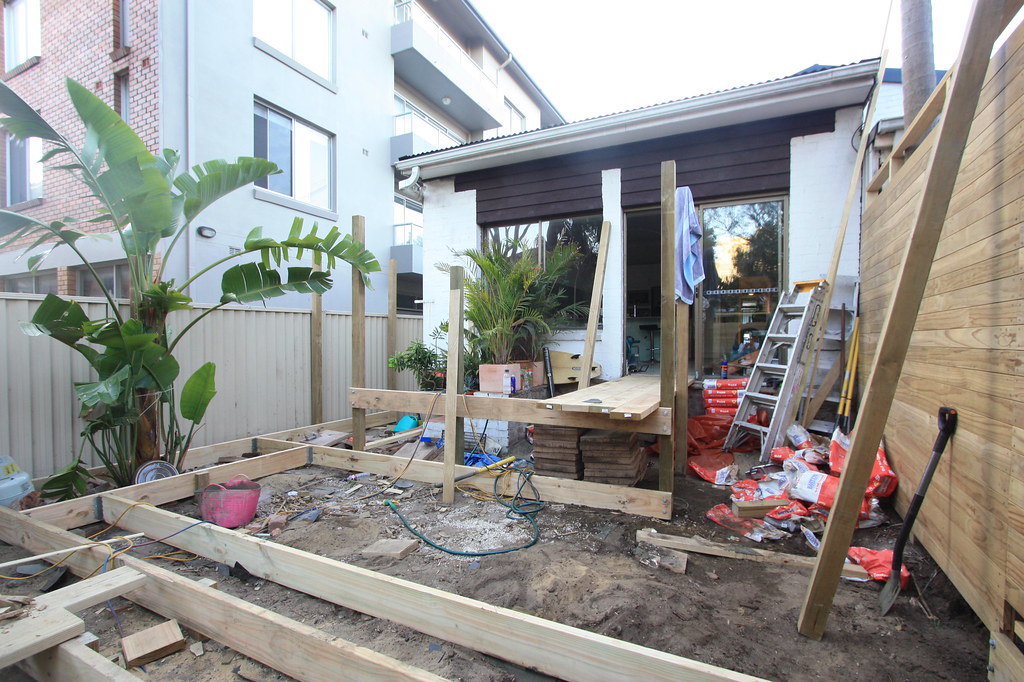
Backyard Progress: LipglossJunkie (CC BY-NC-SA 2.0)
With a projected population decline ahead of Australia, investment in new housing may be unnecessary. Considering the population projections, economic recovery could instead be channelled into improving existing housing. One of the most effective interventions in this pandemic involved repurposing existing accommodation: using hotels and empty student accommodation to house rough sleepers, as well as essential workers who could not isolate at home. This happened through activation of government interventions, public-private partnerships and a focus on socially good outcomes – and has been innovative by international standards. Likewise, existing residential housing could be improved through partnerships between government and the private sector. Newly reported declining median rents in the private rented residential stock in Victoria’s capital, Melbourne, and associated increased vacancy rates represent an opportunity for long-run disruption to existing rental returns. Relatively high vacancy rates and low rents in the inner city disrupt the status quo. These post-pandemic types of housing market dynamics offer governments and not-for-profit organisations new opportunities for housing very low-income residents more affordably. Supported, longer-term leasing agreements could benefit tenants, investor landlords (who may otherwise have empty rental dwellings) and the economic viability of urban neighbourhoods (by bringing tenants back to the city centre).
In the important realm of social housing, a renovation and retrofitting plan has already been laid out which, in its initial stages, focuses on improving the liveability and utility of existing social housing stock as well as other forms of residential dwellings – potentially including those identified above that are now more affordable and accessible due to the impacts of COVID-19. This is a rapid response to the absolute supply shortage of affordable, stable rental housing, and one which was overlooked in the recent Federal Budget. But many housing and urban studies academics in Australia have pointed to the economic benefits and employment opportunities of constructing and improving social housing. The Victorian State Government recently announced a massive investment in social housing in its State Budget – a welcome move, and one that further highlights the problems with pre-pandemic housing.
Lesson 2: Housing for health and wellbeing
Existing housing stock could be better utilised in an adaptive and ultimately transformative way in support of population health and wellbeing. An important part of how urban planners and housing policymakers design our housing futures in high-density cities is to create health-promoting living environments. This includes incorporating adaptive spaces, green spaces and other amenities with health benefits. So, how can we do this in the short-term, with existing stock?
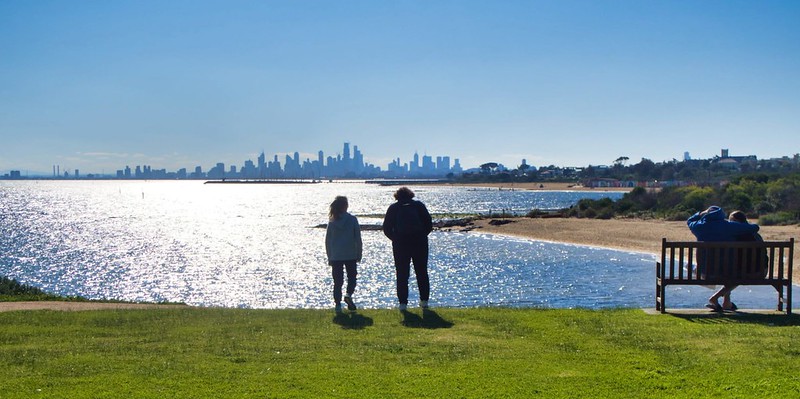
137/366 Iconic view of Melbourne from Green Point: imageo (CC BY-NC-SA 2.0)
The relationship between housing and place has been changed in the pandemic in ways that open opportunities. The long discussed “20-minute city” can occur from anywhere for people working in particular industries, with the right digital connectivity and technology. “20-minute city” refers to neighbourhoods where work, leisure, shopping and other necessary and optional activities are within a 20-minute distance from inhabitants’ homes. It might be more important than ever before to consider allocating spaces for community co-working places or partially (e.g. on specific days or times) reusing roads and carparks as outdoor restaurants or community areas. There are successful examples of similar actions from the past (e.g. from Copenhagen, or in Melbourne’s laneways) that we can tap on, learn from and replicate considering contextual adaptations.
Another example relates to the Victorian Government’s rule from 2 August–13 September that people in metropolitan Melbourne could only use green space for exercise, not leisure. This measure was borne most harshly by those without a yard on their property. For people in units and apartments, public parks and other green spaces normally fulfil the role of a yard where they can relax outdoors. Green spaces are found to contribute to peoples’ overall mental and physical health and wellbeing. To increase health and wellbeing (or if such restriction were to return in the future), more unit and apartment complexes should be creating gardens on rooftops or other underutilised spaces. Examples that can be considered here are greening in-between spaces such as lanes or rooftops, as well as the consideration of micro-urban-forests employing native plantations in Australian cities.
During the pandemic, residents in higher density residential buildings in the city have spent more time inside the house, and vacant car parking increased dramatically due to the absence of temporary residents who couldn’t return to Australia. These empty carparks inside the buildings have been labelled ‘Dead Space’, but they have transformative capacities for dwellers to improve their quality of life and wellbeing by re-imagining their sense of place. This (temporary) transition of reusing the existing car parks (and other empty spaces in buildings) might be granted as home renovations, community creative placemaking and connected communities at different scales of state and local government. By converting such spaces into green, sustainable home-based flexible spaces, longer-term sustainable, resilient housing can be made. Engaging the collaboration of residents in repurposing underutilised spaces to be creative and dynamic, can in turn empower them to step into the action of place governance.
Lesson 3: Housing for productivity
Retrofitting for resilience also relates to the private residential housing sphere. Working-from-home has been a challenge for many whose homes are not easily transformed into a workspace. There is a stark gap between those who have access to a private study and those who must utilise a bedroom, a kitchen table or any available free surface. This is to say nothing of the challenges brought on by working while sharing a home with family, children and/or housemates. At least some of the challenges of working-from-home could be fixed through renovation. Given the reality that many Australians will be working-from-home for the foreseeable future, even after restrictions are over, it would be worthwhile to start engineering homes to better function as workplaces. Simple renovations could include better wall insulation to increase privacy and block out the noise of other household members and neighbours, and improving windows to block outdoor noise. Improvements in thermal comfort (heating and cooling), proper ventilation and lighting are needed. Working from home is based on the assumption that people are connected to internet that is fast, accessible and affordable. Proper devices and digital literacy is another dimension that needs to be addressed (especially for older and low-income Australians). These kinds of improvements help to increase productivity, but also have a positive effect for physical and mental health. Renovations of this kind could be achieved through a scheme similar to the Federal Government’s HomeBuilder grant, although any effective grant would have to include renters and not just homeowners.
Working-from-home may not suit everyone, for reasons of the nature of work, the need to interact with co-workers or customers, or issues of safety or wellbeing, including isolation. Repurposing collaborative spaces, where this is relevant, can offer the flexibility of working off-site but in a social setting. Examples include revitalisation of the pre-pandemic café-office scene in which workers can share space, while at the same time support economies of local neighbourhoods.
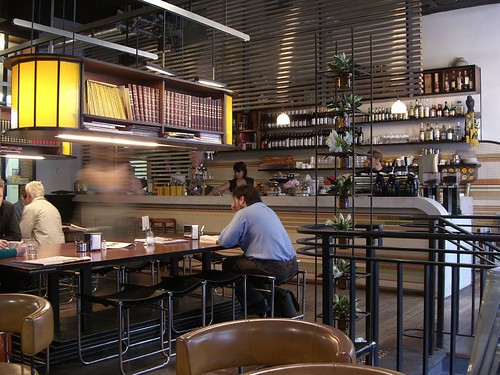
Journal Cafe – Melbourne City Library: avlxyz (CC BY-NC 2.0)
In post-pandemic recovery, a flexible mix of home-based spaces, neighbourhood shared space, and business-as-usual work spaces will be essential for a staged, healthy return to productive urban and regional living. At the same time, this mix provides options for ‘bunkering down’ in the event of future pandemic emergencies.
Charting better housing futures by first ‘taking stock’
The pandemic has changed the way we live our everyday lives, but has also provided an opportunity to re-think the role of our homes and neighbourhoods. The evidence presented here – which resonates with similar accounts from across the globe – indicates that out of the pandemic an opportunity window has emerged in which housing as essential urban infrastructure can be firmly embedded in pathways towards more healthy, sustainable and just housing and urban futures. We argue that meaningful reflections on innovations that emerged from the pandemic, especially ones that can be transformed into healthy, productive and sustainable housing and urban forms, can form part of the first response to urban recovery. Some of the innovations seen in 2020 have shown that taking stock of existing supply might be an important first step. Research shows an absolute supply shortage of social housing and low-cost private rental, but a glut of apartments and some houses. Targeting the renovation of social housing and improving rental stock ought to form part of Australia’s construction-led recovery.
One way to achieve what is needed in both these calls, at least in the short to medium term, is to focus on the housing we have and the role it might play in an innovative housing recovery. How can it be improved? How can it be redistributed? And how can it potentially create the transformative innovations needed for better housing futures?
About the authors
Professor Wendy Stone (Twitter) (Email) is Professor of Housing and Social Policy and Leader of the Housing Futures Research Program within the Centre for Urban Transitions, Swinburne University of Technology.
Zoë Goodall (Email) is a Research Associate in the Centre for Urban Transitions, Swinburne University of Technology.
Dr Piret Veeroja (Email) is a Research Fellow in housing theme in the Centre for Urban Transitions, Swinburne University of Technology.
Dr Fatemeh Shahani (Twitter) (Email) is a Research Fellow in urban sustainability and social cohesion studies in the Centre for Urban Transitions, Swinburne University of Technology.
Margaret Reynolds (Email) is a Researcher in the Centre for Urban Transitions, Swinburne University of Technology.
Professor Niki Frantzeskaki (Twitter) (Email) is Professor of Urban Sustainability Transitions and Director of the Centre for Urban Transitions, Swinburne University of Technology.
